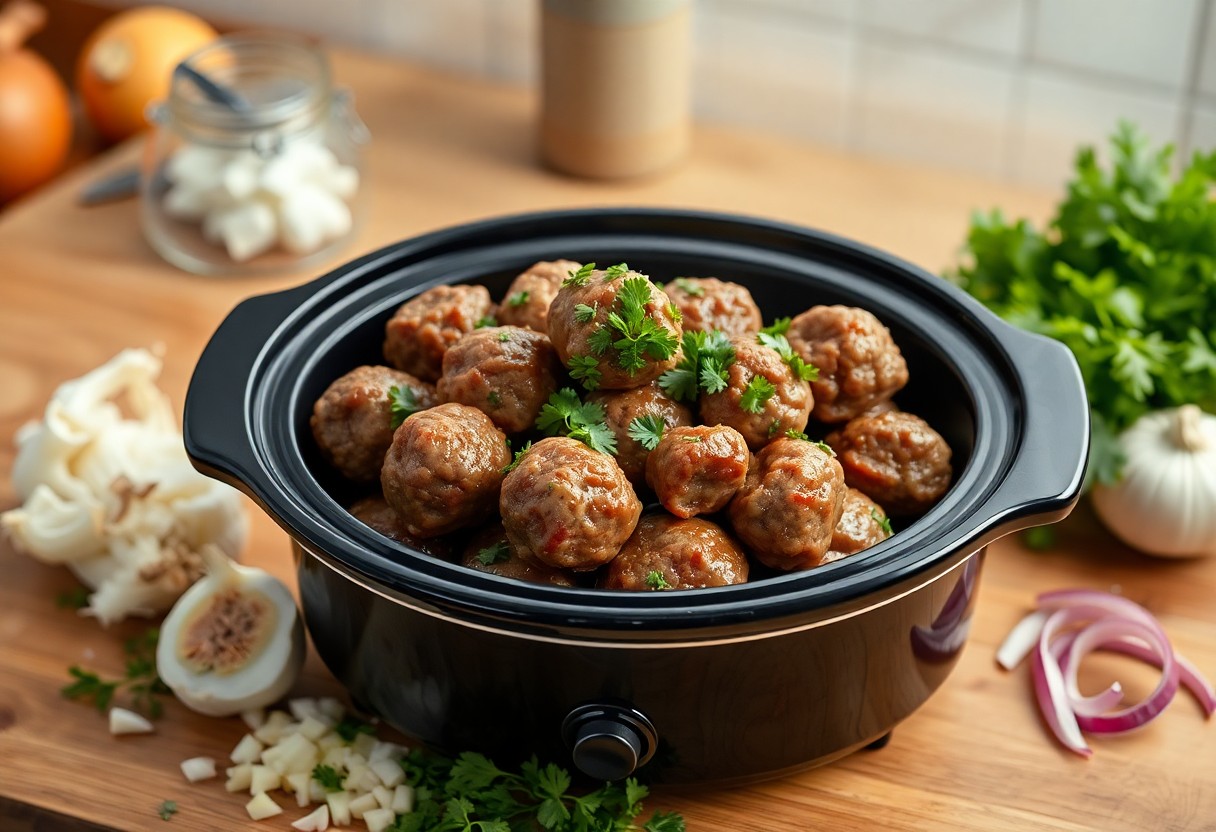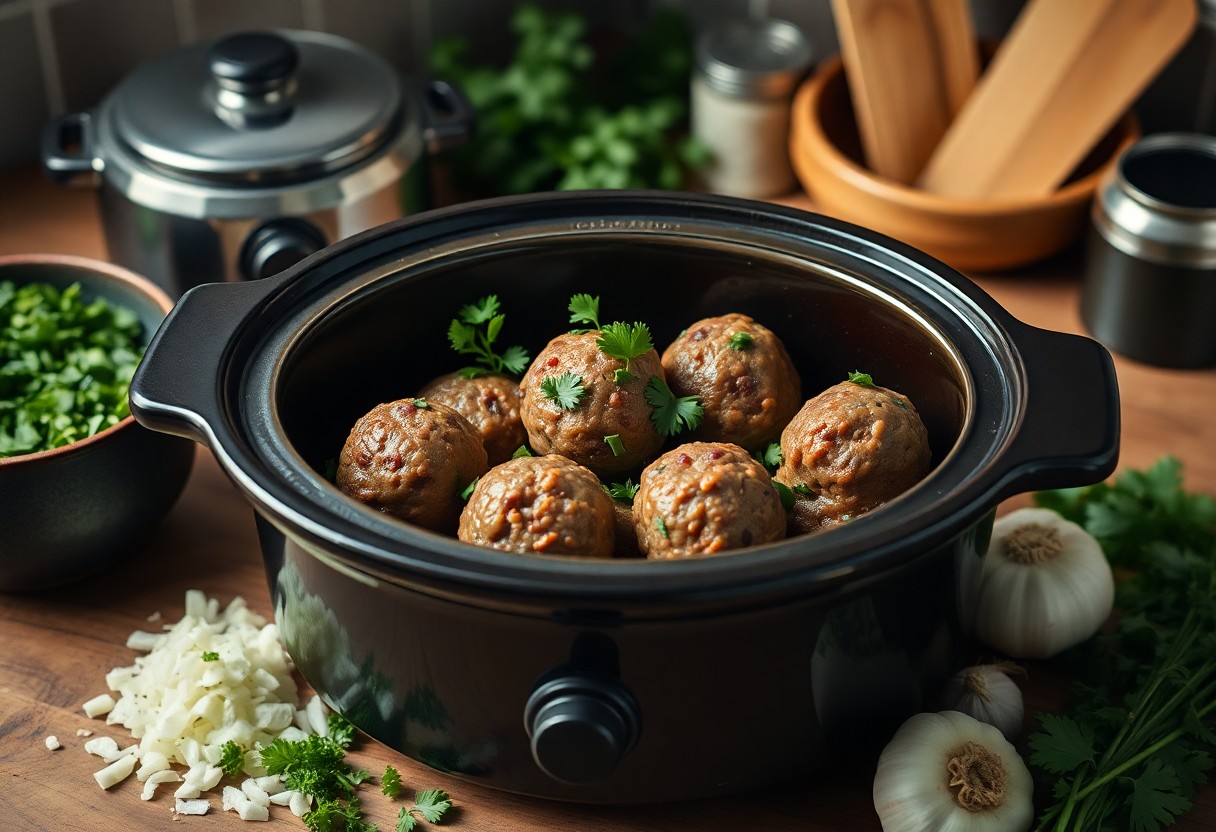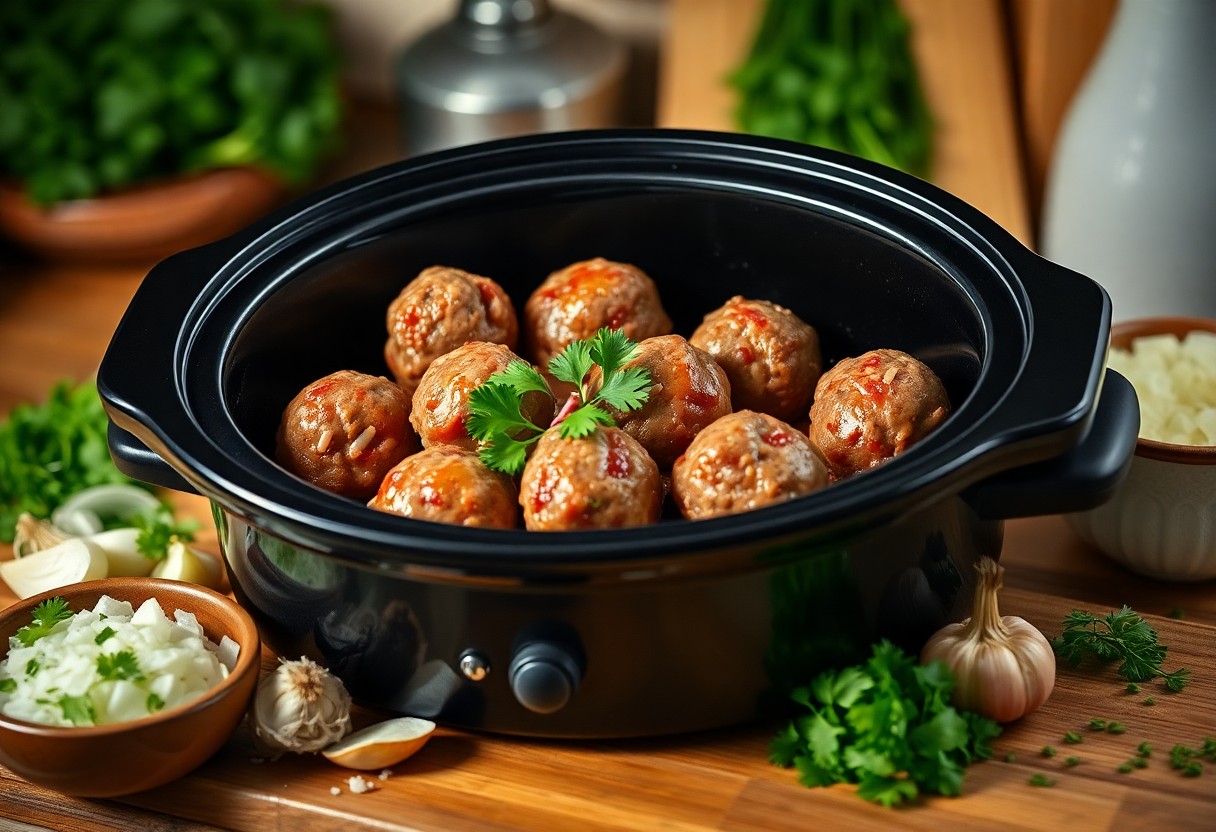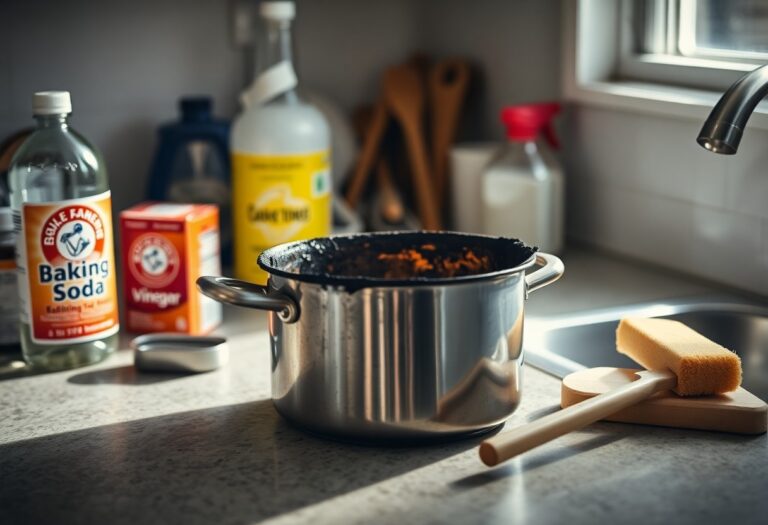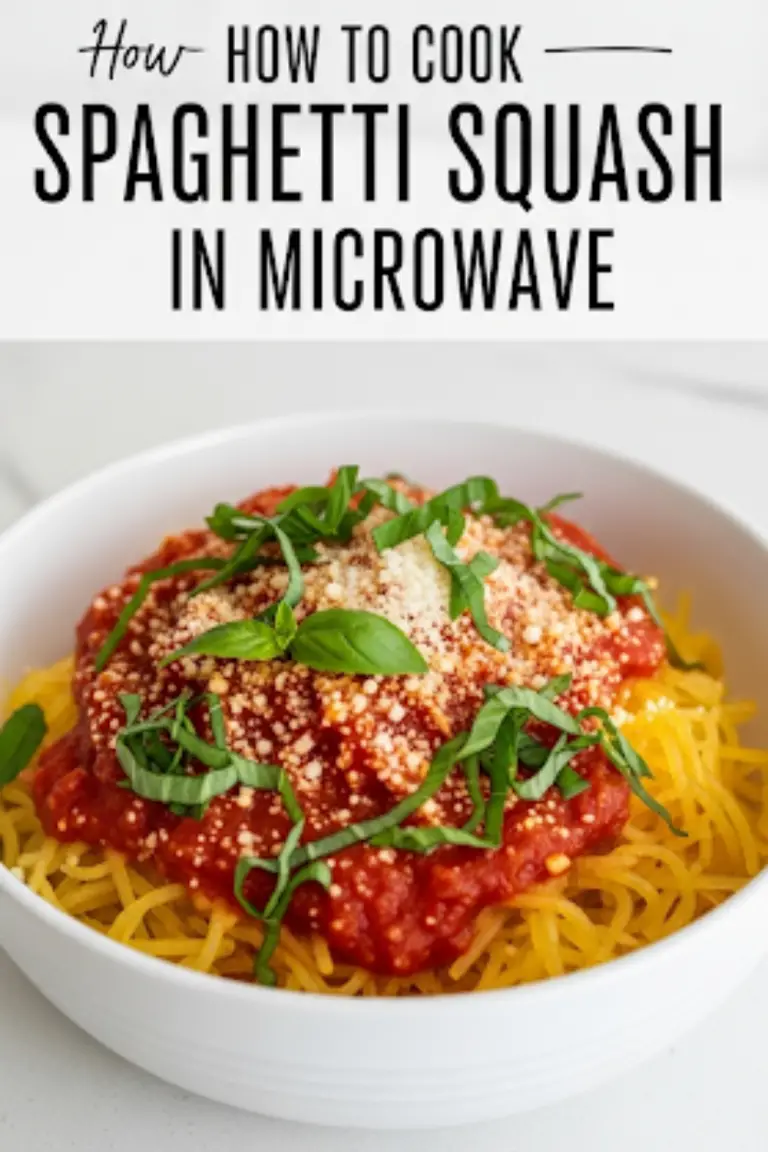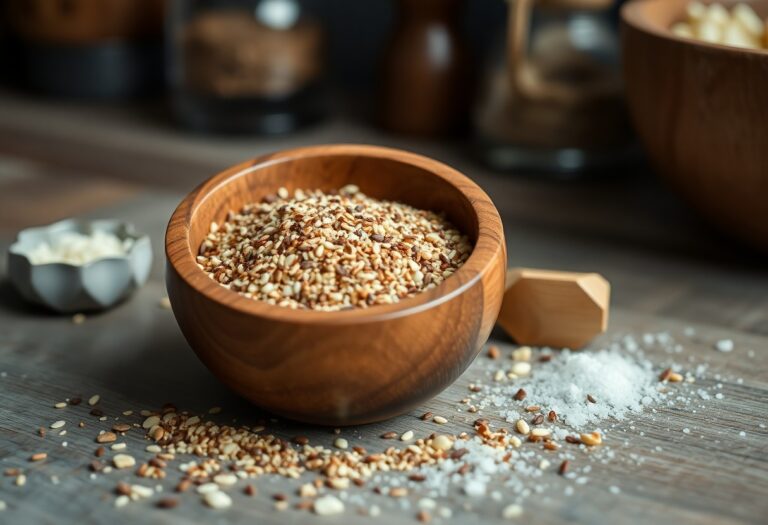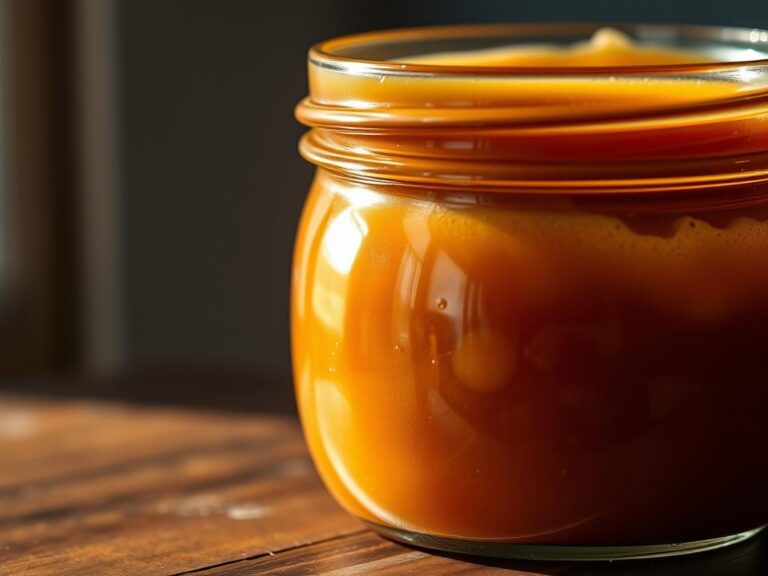how to make meatballs in crockpot
Many home cooks are discovering the convenience and flavor that a crockpot brings to meal preparation, especially when it comes to making delicious meatballs. In this guide, you’ll learn how to create tender, mouthwatering meatballs that will impress your family and friends, all while saving you time and effort. With just a few simple ingredients and steps, you can prepare and let your crockpot do the work, providing you with a hearty meal that is perfect for any occasion. Let’s examine the process of making meatballs in your crockpot!
Crafting the Perfect Meatball Mixture
Choosing the Right Meat Blend
Your choice of meat plays a vital role in the taste and texture of the final product. Ground beef is a popular option, especially if you opt for an 80/20 blend which offers the right balance of flavor and moisture. Alternatively, combining different types of ground meat can elevate your meatballs to new heights. For example, mixing ground pork with beef adds sweetness and richness, while turkey or chicken can provide a lighter option if you’re looking for something healthier. Experimenting with various blends can give you a unique flavor profile that sets your meatballs apart from the rest.
Essential Ingredients for Flavor and Texture
Beyond the meat, the ingredients you mix in will impart important flavors and enhance the texture of your meatballs. A typical blend includes breadcrumbs, eggs, and parmesan cheese, each contributing to the overall integrity of the meatball. Breadcrumbs act as a binder and absorb moisture, keeping the meatballs from becoming dry during cooking, while eggs provide binding properties that help maintain shape as they cook. Parmesan cheese not only amplifies savory notes but also adds a slight nuttiness that can elevate the dish.
Fresh herbs like parsley or basil, along with onions and garlic, can infuse your meatballs with an aromatic zing that takes them to the next level. These ingredients should be chopped finely and mixed evenly to ensure every bite is full of flavor. Additionally, a touch of seasoning such as salt, pepper, and even crushed red pepper flakes can elevate the taste. Keep in mind that the proportions matter; a good rule of thumb is one cup of breadcrumbs and one egg for every pound of meat, adjusting as necessary to achieve the perfect balance between moistness and structure for your meatballs.
Flavor Elevation Techniques
Herbs and Spices that Make a Difference
Incorporating a variety of herbs and spices transforms your meatballs from ordinary to extraordinary. Fresh herbs like parsley, basil, and thyme add brightness and depth. For a bit of warmth, consider adding crushed red pepper flakes or a dash of smoked paprika, which gives your dish a subtle smokiness. Garlic and onion powder are imperative pantry staples that enhance the savory flavor profile. Don’t shy away from experimenting with Italian seasoning blends or even Moroccan spices like cumin and coriander for a unique twist that evokes different culinary traditions.
Additional Ingredients for Unique Twists
To elevate your meatballs further, think outside the box by introducing unexpected ingredients that can infuse additional flavors and textures. Adding grated Parmesan cheese not only increases richness, but the umami kick will deepen the taste. Chopped sun-dried tomatoes can introduce a tangy sweetness, while breadcrumbs mixed with minced olives can add a briny note that complements the meat. Even a splash of Worcestershire sauce or soy sauce can significantly enhance the umami profile, offering a savory depth that you wouldn’t expect in traditional recipes.
Another exciting avenue for unique twists involves incorporating fruits and vegetables into your meatball mixture. Finely shredded zucchini or carrots provide moisture and subtle sweetness, while diced bell peppers or spinach add vibrant colors and nutrients. You could even add a bit of finely chopped apple or pear for an unexpected sweetness that contrasts beautifully with the rich meat. Each of these additions works not only to enhance flavor but also to maintain the best texture, giving you moist, flavorful meatballs that stand out in any dish.
The Ultimate Sauce Selection
Traditional vs. Non-Traditional Sauces
Classic marinara sauce is a timeless choice for meatballs, offering a balance of acidity and sweetness that perfectly complements the savory flavors of the meat. This sauce typically includes tomatoes, garlic, onion, and a medley of herbs such as basil and oregano, creating a rich depth that enhances your dish. For a twist, consider alternatives like BBQ sauce or teriyaki sauce for a more adventurous flavor profile. These non-traditional options can introduce a delightful sweetness and tang, transforming your meatballs into something uniquely satisfying that moves beyond the standard Italian fare.
If you’re feeling bold, experimenting with a peanut sauce or a spicy sriracha-infused glaze can elevate your meatball game to new heights. This infusion of bold flavors not only changes the overall taste but also allows you to cater to various dietary preferences and international cuisines, creating a buffet of deliciousness right in your slow cooker. The versatility of sauces means you can tailor the meal to your gathering, whether it’s a family dinner or a party with friends.
Pairing Sauces with Meatball Varieties
Each meatball variety shines with its own unique sauce selections, making pairing an art in itself. For instance, beef or pork meatballs pair exquisitely with rich tomato sauces, where the robust flavors harmonize seamlessly. Meanwhile, chicken or turkey meatballs often benefit from light and tangy sauces, such as a lemon-garlic concoction or a creamy Alfredo, which don’t overpower the milder taste of the poultry. You might also find that vegetarian meatballs are fantastic when served with traditional marinara or even a zesty chimichurri, opening the door to exciting culinary combinations without meat.
Considering dietary preferences and flavor dynamics is key when creating a meal that everyone can enjoy. If you choose pork and beef meatballs seasoned with garlic and herbs, they will thrive in a traditional marinara, whereas turkey meatballs may benefit from something lighter, like a sesame ginger sauce. Experimenting with these pairings can yield delightful surprises, enhancing the overall flavor experience and ensuring your crockpot meal is the highlight of any gathering. For an easy-to-follow recipe that showcases the perfect marriage of meatballs and sauce, check out this Slow Cooker Meatballs in Tomato Sauce Recipe for further inspiration.
Setting Up Your Crockpot for Success
Optimal Heat Settings and Cooking Time
Selecting the right heat setting for your crockpot is vital for achieving perfectly cooked meatballs. Generally, you have two primary heat options: low and high. Opting for the low setting typically allows for a longer cooking time, about 6 to 8 hours, making it ideal for busy days when you want to set it and forget it. In contrast, if you’re short on time, the high setting can cook your meatballs in approximately 3 to 4 hours, providing a quicker turnaround without sacrificing flavor or texture.
Prepping the Crockpot: Greasing and Layering
To avoid unneeded sticking and ensure an easy clean-up afterward, greasing the inside of your crockpot is crucial. A simple spray of cooking oil or a light coating of butter on the bottom and sides can make a remarkable difference. This quick step helps the meatballs to release easily and prevents their sauce from burning on the bottom of the pot, which is a common issue in slow cooking.
Layering also plays a significant role in how your meatballs cook. Begin by placing a layer of sauce on the bottom of the crockpot before adding your meatballs. This not only keeps them moist but allows them to absorb more flavor during the cooking process. Arranging the meatballs in a single layer will help them cook evenly. If your recipe yields many meatballs, consider cooking in batches or using a larger capacity crockpot to avoid overcrowding. Overcrowding can lead to uneven cooking and tough meatballs, so giving them space is key.
Incorporating additional flavor elements like sliced onions or chopped bell peppers between the layers of meatballs and sauce can also elevate your dish. This not only enhances the taste but adds vibrant colors, making your meal visually appealing. The combination of proper grease application and thoughtful layering creates a foundation for a successful meatball dish in your crockpot, ensuring maximum flavor and texture with every bite.
Troubleshooting Common Pitfalls
Ensuring Even Cooking and Avoiding Dryness
To achieve perfectly cooked meatballs in your crockpot, layering is key. Start by placing larger, dense ingredients like vegetables at the bottom of the pot, which allows them to create a steaming environment that promotes even cooking. Arrange your meatballs in a single layer atop this base, and if they need to be stacked, consider gently repositioning them halfway through cooking to ensure that all sides get the chance to absorb moisture and flavor. Also, keeping the lid sealed during cooking is imperative; this traps steam, which keeps your meatballs moist. A tendency to lift the lid frequently can lead to significant temperature fluctuations, ultimately drying out your dish.
Adapting Recipes for Larger or Smaller Batches
Adjusting recipes for different batch sizes can lead to more successful meal prep and avoid waste. When reducing your meatball quantity, maintain the same proportion of ingredients, particularly binders like breadcrumbs or eggs, as they are imperative for texture and flavor. Conversely, if you’re increasing the size of your batch, you must also ensure there is enough room in your crockpot for them to cook evenly without crowding, which can compromise browning and moisture retention. A general rule is not to exceed two-thirds of the pot’s capacity, allowing proper circulation of heat and steam.
For instance, if you have a recipe that yields 12 meatballs and you want to double it, you’ll require about 2 pounds of ground meat, as opposed to just increasing the meat by a single pound, which could result in a drier end product due to inadequate binding. Balancing flavors while also adjusting cooking times slightly for larger quantities can be tricky; larger batches may require additional cooking time, so checking for doneness with a meat thermometer ensures that the internal temperature of the meatballs reaches 160°F without overcooking them. This approach ensures your additions don’t compromise the quality and taste appreciation of your final dish.
To wrap up
With these considerations, you are well-equipped to create delicious meatballs in your crockpot effortlessly. Focus on selecting the right mix of meat, spices, and binders for your desired flavor and texture. Don’t hesitate to experiment with various sauces or vegetables to enhance your dish further. The slow cooking method will allow the flavors to meld beautifully, resulting in tender and savory meatballs that are sure to impress.
As you prepare your meatballs, take advantage of the convenience that the crockpot offers. It gives you the freedom to multitask while your meal cooks slowly and evenly. By planning ahead and following the easy steps to achieve your mouthwatering dish, you ensure a satisfying dinner for yourself or your loved ones. Enjoy the process, and savor the delightful outcomes of your culinary efforts!
FAQ
Q: What ingredients do I need to make meatballs in a crockpot?
A: To make meatballs in a crockpot, you will need ground meat (beef, turkey, or chicken), breadcrumbs, eggs, grated cheese, garlic, onion, herbs (like parsley or oregano), salt, pepper, and your choice of sauce (tomato sauce, barbecue sauce, etc.). You can also add vegetables such as bell peppers or mushrooms for extra flavor and nutrition.
Q: How long does it take to cook meatballs in a crockpot?
A: Cooking meatballs in a crockpot typically takes about 4 to 6 hours on low or 2 to 3 hours on high. The cooking time may vary slightly depending on the size of the meatballs and the heat settings of your crockpot. It’s important to ensure that the meatballs reach an internal temperature of 160°F (71°C) for safety.
Q: Can I use frozen meatballs in a crockpot?
A: Yes, you can use frozen meatballs in a crockpot. If they are pre-cooked, you can add them directly to the sauce and cook on low for about 4 to 5 hours or on high for 2 to 3 hours. If the meatballs are uncooked, you will want to ensure they cook thoroughly, which may take longer. Adjust the cooking time based on whether the meatballs are frozen or thawed before cooking.
Q: How do I ensure my meatballs are moist and flavorful?
A: To keep your meatballs moist and flavorful, use a combination of ground meat and add moisture through ingredients such as eggs and breadcrumbs soaked in milk. Including herbs, spices, and grated cheese can also enhance flavor. Mixing the ingredients gently without overworking the meat is important to maintain tenderness.
Q: What can I serve with crockpot meatballs?
A: Crockpot meatballs can be served in various ways. They are delicious on their own, but you can serve them over spaghetti or rice for a heartier meal. Alternatively, they make great meatball subs when placed in a hoagie roll with cheese. Pairing them with a side salad or roasted vegetables can create a well-rounded meal.

